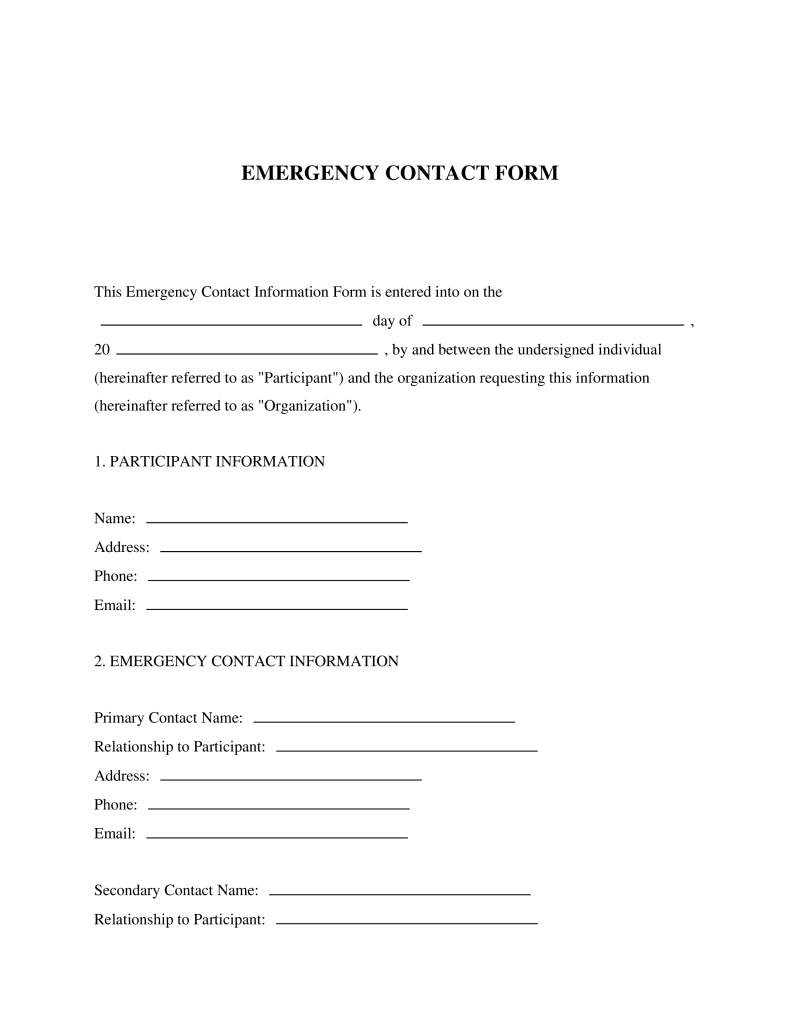An Emergency Contact Form is a legal document that designates individuals to be contacted in case of an emergency.
Full Name
Write your full legal name as it appears on official documents, including your first name, middle name (if applicable), and last name. For example, if your name is John Michael Smith, write it exactly like that. This information is important for identifying you in legal matters, so make sure it is accurate.

Table of Contents
What is an Emergency Contact Form?
An Emergency Contact Form is a critical document that facilitates the collection of essential contact information needed to reach out to designated individuals in the event of an emergency. Typically utilized within workplaces, schools, and by individuals living alone or with chronic medical conditions, this form serves as a quick reference for emergency responders, employers, and caregivers to ensure timely communication during unforeseen situations. It not only streamlines the process of gathering vital contacts but also minimizes delays in emergencies, potentially saving lives. Employers, in particular, find an emergency contact form for employees indispensable for maintaining a safe working environment and fulfilling their duty of care obligations.
Key Features
Important Provisions
- A detailed section capturing primary and secondary emergency contacts' names, relationships, and multiple contact numbers.
- Clauses regarding the circumstances under which the form can be used, emphasizing its use strictly in emergencies.
- Privacy assurances that detail how personal information will be stored, accessed, and protected.
- Instructions on how often the form should be updated and by whom, ensuring current information is always on file.
Pros and Cons
Pros
- +Streamlines the process of contacting next-of-kin or designated individuals during emergencies.
- +Enhances workplace safety by ensuring quick access to emergency contact details.
- +Reduces liability risks for organizations by demonstrating a proactive approach to emergency preparedness.
- +Builds trust among employees or participants by showing concern for their well-being.
- +Simplifies administrative tasks related to maintaining up-to-date contact records.
Cons
- -Requires regular updates to ensure the information remains current and accurate.
- -May raise privacy concerns among individuals wary of sharing personal details.
- -Dependent on the honesty and thoroughness of the information provided by employees or participants.
Common Uses
- In onboarding paperwork for new employees to ensure immediate access to emergency contacts.
- Within schools and daycare centers for quick reference in case a student requires urgent care.
- For sports teams and clubs where physical activity increases the risk of accidents or injuries.
- In healthcare settings, particularly for patients with chronic conditions who may require sudden intervention.
- During travel preparations, especially for groups or tours, to maintain a record of whom to contact in emergencies abroad.
- By landlords or residential communities as part of tenant agreements for use in property-related emergencies.
Frequently Asked Questions
Do you have a question about an Emergency Contact Form?
Example questions:
Not the form you're looking for?
Try our legal document generator to create a custom document
Community Discussion
Share your experience and help others
Legal Notice: Comments are personal opinions and do not constitute legal advice. Always consult a qualified attorney for matters specific to your situation.
Comments (0)
Leave a Comment
No comments yet. Be the first to comment!